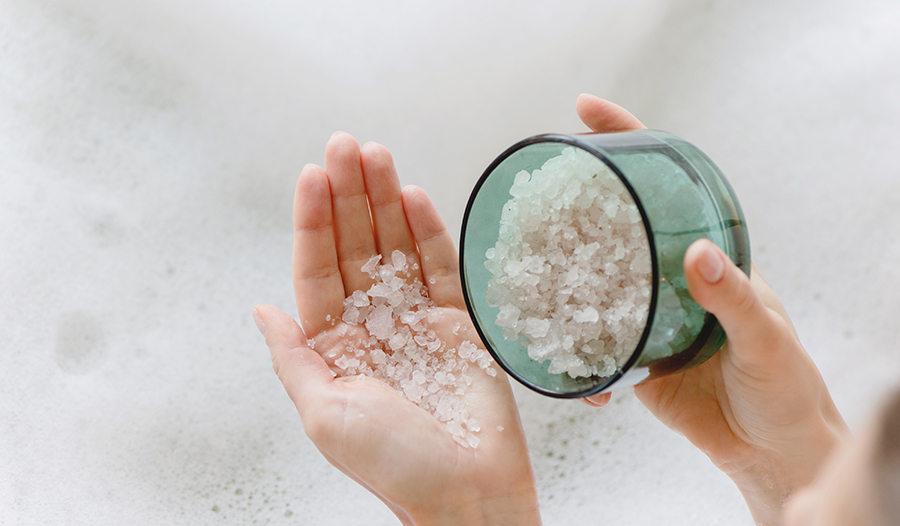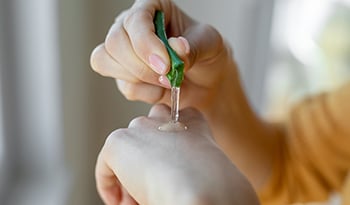Epsom Salt Benefits and Uses
DISCLAIMER:This blog does not intend to provide diagnosis...
- In this article:
- What Is Epsom Salt?
- Epsom Salts Are Rich in Magnesium
- Health Benefits of Epsom Salt
- Safety and Side Effects of Epsom Salt
- How to Use Epsom Salt
- Other Epsom Salt Uses
- How Will You Use Epsom Salt?

What Is Epsom Salt?
Epsom salt, or magnesium sulfate, is a compound composed of magnesium, sulfur, and oxygen. Epsom salt has a similar texture and structure to table or finishing salt, which gives it its salt-like appearance. However, while Epsom salt has the word “salt” in its name, it is not truly a salt as we would typically think of for the table, baking, or as a finishing salt.
Epsom salt naturally occurs and is made by evaporating water from lakes that are naturally rich in magnesium sulfate.
Epsom salts were first discovered by accident by Henry Whicker in 1618 in a town called Epsom, located southwest of London. Henry led his cows to a pond for a drink of water—but the cows refused to drink it. Upon closer inspection, he noticed that the water was bitter and, when evaporated, provided a white, granulated salt. Later, people noticed that animals that waded in these same waters experienced improved healing for cuts and sores. This was just the beginning of the research and appreciation for Epsom salt’s many benefits.
While Epsom salt is most often used for its health benefits, its many uses range from gardening to crafting and more!
Epsom Salts Are Rich in Magnesium
One of the hero compounds in Epsom salt is magnesium. Magnesium is a mineral that plays many important roles within the body, from supporting heart health, blood sugar levels, muscle contraction, relaxation, and more. In fact, magnesium is responsible for more than 600 different biochemical reactions within the body, including protein synthesis, muscle and nerve function, blood glucose control, blood pressure regulation, and liver detoxification pathways.1,2 Still, more than 50% of Americans consume less than optimal amounts of magnesium or are deficient in magnesium.3
Groups of people at risk of magnesium deficiency include those with gastrointestinal disease, type 2 diabetes, people with alcohol dependence, and older adults. Signs and symptoms of magnesium deficiency can include muscle cramps, twitching, osteoporosis, fatigue, weakness, anxiety, high blood pressure, irregular heartbeat, and asthma.
Foods rich in magnesium include pumpkin seeds, chia seeds, almonds, cashews, spinach, black beans, peanut butter, brown rice, and salmon. Magnesium can also be added to the diet through supplements, whether in capsule form, powdered drink mixes, or Epsom salt baths!
Health Benefits of Epsom Salt
What does Epsom salt do for your health? Epsom salts have been used for centuries for their healing and nourishing properties, largely thanks to their high magnesium content. Below are a variety of Epsom salt benefits
Pain and Muscle Ache Relief
Magnesium plays an important role in muscle relaxation, which can support pain relief. When soaking in an Epsom salt bath, your body absorbs the mineral magnesium through your skin. Magnesium can help relax muscles, reduce swelling, and reduce pain.
Constipation Relief
Epsom salts can be used internally and externally to achieve a laxative effect in those experiencing constipation. For internal use, mix 1 to 2 teaspoons of Epsom salt with filtered water. For external use, try an Epsom salt bath! Soaking in a warm, magnesium-rich Epsom salt bath may help relax the digestive tract and soften stools, resulting in a bowel movement.
Always consult with your medical doctor before taking any new supplement and before using Epsom salts internally to ensure that it is safe for you and won’t interact with any medications you currently take.
Relaxation and Sleep Support
Research suggests magnesium may help you get a better night’s sleep.4 An Epsom salt bath before bed may improve sleep quality by helping you fall asleep faster and reducing insomnia symptoms, mid-night wakings, and early morning wakings.
Heart Health
The heart, which is a muscle, benefits greatly from magnesium. In fact, studies have shown that those who are deficient in magnesium have an increased risk of heart disease, type 2 diabetes, high blood pressure, and depression.5 Magnesium is essential for a healthy heart rhythm and supports the transportation of potassium and sodium across cell membranes, additional key nutrients for heart health.
Liver Detoxification
Magnesium and sulfate, two compounds in Epsom salt, can help stimulate detoxification pathways within the body, aiding the detoxification process. The liver is an important detox organ, and there are two phases in the liver detox process. Magnesium is involved in the second phase, assisting with the excretion of toxins from the body through urine, stool, and sweating.6
Relief From Breast Engorgement Associated With Breastfeeding
Breast engorgement can occur when a mother’s breasts become overly full of breast milk. Breast engorgement can be uncomfortable and painful. An Epsom salt bath can help relieve engorgement-associated breast pain. Fully submerging the breasts in an Epsom salt bath and then pumping, nursing, or hand expressing can help relieve breast engorgement.
Relief From Clogged Ducts From Breastfeeding
Similar to how Epsom salts can help relieve pain from breast engorgement, they can also soften and help clear a clogged duct. Fully submerging the breasts in an Epsom salt bath and then pumping, nursing, or hand expressing can help relieve a clogged duct.
Safety and Side Effects of Epsom Salt
Epsom salts are generally considered safe when used externally. Using Epsom salts internally produces a laxative effect that can result in dehydration, digestive distress, and diarrhea. Before taking Epsom salts internally, consult with your medical doctor to confirm that it is safe for you and won’t interact with any medications or other supplements you currently take.
How to Use Epsom Salt
From Epsom salt baths for muscle ache relief to DIY beauty products, there are many uses for Epsom salts.
Epsom Salt Bath
There are many Epsom salt bath benefits, but you must know how to prepare one first. To prepare an Epsom salt bath, add 1 to 2 cups of Epsom salts to a standard-size bathtub filled with warm water. You may need to swish the salts around in the water to help them dissolve. Do not add Epsom salts to a hot tub or a tub with jets—the salts could clog or impact the function of these types of tubs. Soak in the bath for 15 to 30 minutes or up to one hour to reap the benefits of the Epsom salts.
Try adding essential oils to your Epsom salt bath for further relaxation. The following essential oils work well with Epsom salts:
Epsom Salt for Beauty
Epsom salt can be used to make an effective homemade exfoliating salt scrub for removing dead skin cells, increasing circulation, and supporting lymphatic health.
Epson Salt Scrub Recipe
Ingredients:
- ½ cup Epsom salt
- ¼ cup coconut oil (melted) or olive oil
- 1 teaspoon of dried herbs (see options below)
- 1-5 drops of essential oils (optional)
Directions:
Combine all ingredients in a medium bowl and mix well. Transfer to an airtight glass jar. Store in a cool, dry place and use within three months.
Dried Herbs and Flora for Salt Scrub
- Lavender flower
- Chamomile flower
- Calendula flower
Gardening With Epsom Salts
Yes! You can use Epsom salt for plants. Magnesium and sulfur, two naturally occurring minerals that are major components of Epsom salts, may help plants grow greener with higher yields and more blooms, according to the Epsom Salt Council. “Magnesium creates an environment conducive to growth by helping seeds germinate, increasing chlorophyll production, and improving phosphorus and nitrogen uptake. Sulfur is also a key element in plant growth, helping produce vitamins,” the council adds.7
Follow these tips to add lushness to your garden and houseplants with Epsom salt:
- Soil preparation: Mix 1 cup of Epsom salt over every 100 square feet of soil or mix into the soil before planting.
- Houseplants: Mix 2 tablespoons of Epsom salt in 1 gallon of water and feed houseplants monthly.
- Trees and Shrubs: Mix 1 tablespoon of Epsom salt in water for every 9 square feet and apply every two to four weeks.
Other Epsom Salt Uses
Epsom salt has many uses, from supporting health to gardening, crafting, and more. Below is a list of great uses for Epsom salts!
- Relaxing Detox Bath: Dissolve Epsom salt in warm water to take a bath.
- Foot soak: Using Epsom salt for feet can soothe achy feet and help remove foot odor.
- Splinter removal: Mix Epsom salt and water and soak hand to help soften skin before removing a splinter.
- Slug prevention: Sprinkle Epsom salt near walkways, door frames, or in the garden.
- Clean pots and pans: Sprinkle Epsom salt on pots and pans to help clean burnt or dried food without scratching.
- Support sleep: Add Epsom salt to a bath for a better night’s sleep.
- Natural exfoliation: Mix Epsom salt and olive oil for a gentle, natural body or facial exfoliation.
- Laundry booster: Add 1 to 2 tablespoons to each load, along with your choice of laundry detergent.
- Tile cleaner: Mix equal parts Epsom salts and dish soap to scrub and clean tiles.
- Hard water stain remover: Combine 1 cup Epsom salts, 1/2 cup baking soda, and 1/4 cup liquid dish soap to clean hard water spots or stains.
- And so many more!
Epsom salts are a key household staple for health, gardening, cleaning, and more!
How Will You Use Epsom Salt?
Epsom salts have been used for centuries for a good reason—this timeless natural remedy has many uses and offers widespread benefits throughout the body. Whether you are looking to relax in an Epsom salt bath or in need of pain relief, Epsom salt can be a great natural supplement to incorporate into your wellness routine.
References:
- Gröber U, Schmidt J, Kisters K. Magnesium in Prevention and Therapy. Nutrients. 2015;7(9):8199.
- de Baaij JHF, Hoenderop JGJ, Bindels RJM. Magnesium in man: implications for health and disease. Physiol Rev. 2015;95(1):1-46.
- Razzaque MS. Magnesium: Are We Consuming Enough? Nutrients. 2018;10(12).
- Zhang Y, Chen C, Lu L, et al. Association of magnesium intake with sleep duration and sleep quality: findings from the CARDIA study. Sleep. 2022;45(4).
- Magnesium. Health Professional Fact Sheet. Accessed March 10, 2024.
- Liu M, Yang H, Mao Y. Magnesium and liver disease. Ann Transl Med. 2019;7(20):578-578.
- Gardening with Epsom Salt. Epsom Salt Council. Accessed March 11, 2024.

 By Megan Roosevelt, RDN
By Megan Roosevelt, RDN


